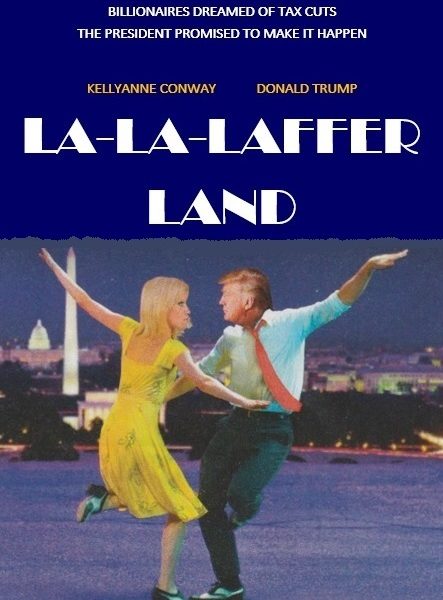
John Christensen ■ President Trump visits La-La-Laffer Land

Taken as a whole, the tax plans just announced by US President Donald Trump, which include abolition of the inheritance tax, could represent the largest tax cut for billionaires and millionaires in US history. According to the President, this will stimulate growth and job creation. There’s no evidence to support this; in fact the evidence suggests the exact opposite.
Under the plans announced yesterday, the range of personal income tax brackets will be ‘simplified’ by reducing them from seven to three (10%, 25% and 35%), while the corporate income tax rate would be more than halved (from 35% to 15%). Bear in mind that the much talked about US corporate income tax rate ‘the highest in the developed world’ is rarely what multinational companies actually pay.
Alongside these adjustments, the President also proposes to reduce the alternative minimum tax, which was introduced to prevent ultra-rich people from exploiting every loophole in the book in order to avoid paying any tax whatsoever. The plan also envisages a comprehensive rolling back of tax reliefs and deductions, although contrary to earlier rumours this will not extend to charitable donations and mortgage interest on home purchases. And, predictably, the plans propose yet another tax amnesty for tax avoiding US multinationals, which, as former US Secretary of Labor Robert Reich points out, has previously failed to stimulate investment or new jobs.
Taken as a whole, President Trump’s proposals, which at this stage are nothing more than a wish list, represent yet another rehash of the weird and wonderful notions of Arthur Laffer. (TJN has commented ad nauseam on Laffer here). Politicians of a certain persuasion (i.e. the self-interested rich ones) are readily seduced by the idea that tax cuts targeting the rich will induce investment, thus stimulating growth, and ultimately yielding more tax revenue than the previous (higher) tax rate.
Art Laffer famously sketched this wonderful concoction out on a chart (known as the Laffer Curve), which has mesmerised world leaders and gullible journalists since the 1980s.
Sadly, however, the body of evidence overwhelmingly shows the Laffer Curve is pure hokum. Cutting taxes on the rich doesn’t stimulate investment (see the UK’s recent experience for example), and neither does it increase revenue yields in the long-term.
When applied to the real world, Laffer’s snake oil has proven disastrous, as the state of Kentucky discovered when its Governor brought Laffer in to jumpstart the economy a few years back.
In recent years economists trying to breathe life into Laffer’s sagging notions have added a fresh twist known as ‘dynamic scoring’, which seeks to show that tax cuts will unleash fresh dynamics into an otherwise flagging economy. Like many economic modelling processes, dynamic scoring relies on a package of variables and assumptions that might, or might not, survive the harsh light of reality. As the Organisation for Economic Cooperation and Development notes:
“We have no idea of the magnitudes of likely responses by households and firms to many of the kinds of tax reforms often proposed in the real world, and still less idea of likely responses to changes in public spending programmes and regulations. We have no macroeconomic model that even incorporates the main features acknowledged by all as desirable, and no consensus on which of the multiplicity of radically different models best captures reality.”
So we’re back in La-La-Laffer Land.
As Maya McGuineas of the Committee for a Responsible Federal Budget commented on Trump’s announcement: “It seems the administration is using economic growth like magic beans – the cheap solution to all our problems. But there is no golden goose at the top of the tax cut beanstalk, just mountains of debt.”
Shortly after taking office President Trump said that corporate tax cuts will help US corporations “compete” in global markets: “My economic team is developing historic tax reform that will reduce the tax rate on our companies so they can compete and thrive anywhere and with anyone.” He added: “It will be a big, big cut.”
In practice, many US multinationals pay little or no tax anywhere, so the proposed 15 percent rate could actually represent a tax hike, but again the evidence shows that tax cuts don’t stimulate investment unless accompanied by measures to stimulate extra demand for goods and services, which will be hard to achieve when the corporate tax cuts will increase US national debt by around $2.4 trillion.
The White House has yet to produce a detailed costing of its full tax plans, which at this stage represent nothing more than an aspiration (see full plan below). Earlier plans for a Border Adjustment Tax, which would have caused significant harm to other countries and most likely contravened World Trade Organisation rules, appear to have been shelved.
Immediate responses to the President’s plans are generally dismissive. The Committee for a Responsible Federal Budget, widely regarded as hawkish on deficits, estimates the overall cost at between $3-$7 trillion, and comments that the plan will: “increase debt to 111 percent of Gross Domestic Product (compared to 89 percent of GDP in CBO’s baseline) by 2027. That would be higher than any time in US history, and no achievable amount of economic growth could finance it.”
TJN expects the plan to run into a wall of opposition from both the Democrats and those members of the Republican Party who haven’t entirely bought into the dreamworld of La-La-Laffer Land.
Billionaires, however, will love it.
Now watch this short video on the hokum of Art Laffer’s ‘supply side’ tax cuts:
Related articles
The millionaire exodus myth
10 June 2025

Inequality Inc.: How the war on tax fuels inequality and what we can do about it

New Tax Justice Network podcast website launched!

The People vs Microsoft: the Tax Justice Network podcast, the Taxcast

Can the UN succeed? Top questions about our State of Tax Justice report

Switzerland’s tax referendum is a choice between tax havenry and more tax havenry

Tax Justice Network Arabic podcast #66: الضريبة الموحدة على الشركات والفرص الضائعة

Monopolies and market power: the Tax Justice Network podcast, the Taxcast

Tax Justice Network Arabic podcast #62: بولط تونس: تسريب معطيات نحو تل أبيب، تهرّب ضريبي وجرائم أخرى




